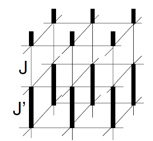Home > Press > Numerical validation of quantum magnetic ordering: Numerical simulations designed to confirm the magnetic characteristics of 3D quantum materials largely match the theoretical predictions
 |
Abstract:
A new study set out to use numerical simulations to validate previous theoretical predictions describing materials exhibiting so-called antiferromagneting characteristics. A recently discovered theory shows that the ordering temperature depends on two factors -- namely the spin-wave velocity and the staggered magnetization. The results, largely consistent with these theoretical predictions, have now been published in a paper in EPJ B by Ming-Tso Kao and Fu-Jiun Jiang from the National Taiwan Normal University, in Taipei.
Numerical validation of quantum magnetic ordering: Numerical simulations designed to confirm the magnetic characteristics of 3D quantum materials largely match the theoretical predictions
Heidelberg, Germany and New York, NY | Posted on October 22nd, 2013In antiferromagnetic materials, the spins of electrons align in a regular pattern pointing in opposite directions to their neighbours. The materials' magnetic ordering conditions the temperature, referred to as the Néel temperature, above which the macroscopic magnetic ordering is no longer present.
The authors attempted to confirm a new universal law established between the thermal and quantum properties of these three-dimensional quantum antiferromagnets. Specifically, the law suggests that the Néel temperature can be related to the staggered magnetisation density near a quantum critical point (QCP). At that point, there is a special class of continuous magnetic phase transition taking place at the absolute zero of temperature, driven by quantum-level fluctuations.
In order to produce quantitative predictions, they simulated a specific three-dimensional relevant model using the first principles of approximation-free Monte Carlo calculations. The authors thus extracted the Néel temperature, the zero-temperature staggered magnetisation in the system and the spinwave velocity.
They found that the universal relation is valid to a great extent, while there is a discrepancy between the theoretical predictions and the simulation results. Further investigation, they believe, is required in order to better understand the discrepancy. For example, this could mean investigating whether the predicted universal relation is valid qualitatively or quantitatively for the same type and different type of quantum phase transitions occurring in other models than that considered here.
####
For more information, please click here
Contacts:
Franziska Hornig
49-622-148-78414
Copyright © Springer
If you have a comment, please Contact us.Issuers of news releases, not 7th Wave, Inc. or Nanotechnology Now, are solely responsible for the accuracy of the content.
| Related Links |
| Related News Press |
Physics
![]() Simulating magnetization in a Heisenberg quantum spin chain April 5th, 2024
Simulating magnetization in a Heisenberg quantum spin chain April 5th, 2024
News and information
![]() Simulating magnetization in a Heisenberg quantum spin chain April 5th, 2024
Simulating magnetization in a Heisenberg quantum spin chain April 5th, 2024
![]() NRL charters Navy’s quantum inertial navigation path to reduce drift April 5th, 2024
NRL charters Navy’s quantum inertial navigation path to reduce drift April 5th, 2024
![]() Discovery points path to flash-like memory for storing qubits: Rice find could hasten development of nonvolatile quantum memory April 5th, 2024
Discovery points path to flash-like memory for storing qubits: Rice find could hasten development of nonvolatile quantum memory April 5th, 2024
Discoveries
![]() Chemical reactions can scramble quantum information as well as black holes April 5th, 2024
Chemical reactions can scramble quantum information as well as black holes April 5th, 2024
![]() New micromaterial releases nanoparticles that selectively destroy cancer cells April 5th, 2024
New micromaterial releases nanoparticles that selectively destroy cancer cells April 5th, 2024
![]() Utilizing palladium for addressing contact issues of buried oxide thin film transistors April 5th, 2024
Utilizing palladium for addressing contact issues of buried oxide thin film transistors April 5th, 2024
Announcements
![]() NRL charters Navy’s quantum inertial navigation path to reduce drift April 5th, 2024
NRL charters Navy’s quantum inertial navigation path to reduce drift April 5th, 2024
![]() Discovery points path to flash-like memory for storing qubits: Rice find could hasten development of nonvolatile quantum memory April 5th, 2024
Discovery points path to flash-like memory for storing qubits: Rice find could hasten development of nonvolatile quantum memory April 5th, 2024
Quantum nanoscience
![]() Simulating magnetization in a Heisenberg quantum spin chain April 5th, 2024
Simulating magnetization in a Heisenberg quantum spin chain April 5th, 2024
![]() Optically trapped quantum droplets of light can bind together to form macroscopic complexes March 8th, 2024
Optically trapped quantum droplets of light can bind together to form macroscopic complexes March 8th, 2024
![]() Bridging light and electrons January 12th, 2024
Bridging light and electrons January 12th, 2024
![]() 'Sudden death' of quantum fluctuations defies current theories of superconductivity: Study challenges the conventional wisdom of superconducting quantum transitions January 12th, 2024
'Sudden death' of quantum fluctuations defies current theories of superconductivity: Study challenges the conventional wisdom of superconducting quantum transitions January 12th, 2024
|
|
||
|
|
||
| The latest news from around the world, FREE | ||
|
|
||
|
|
||
| Premium Products | ||
|
|
||
|
Only the news you want to read!
Learn More |
||
|
|
||
|
Full-service, expert consulting
Learn More |
||
|
|
||








